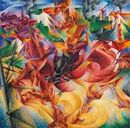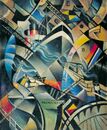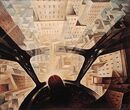No edit summary Tag: Visual edit |
|||
| Line 51: | Line 51: | ||
[[Category:Art movements]] |
[[Category:Art movements]] |
||
[[Category:Candidates for Deletion]] |
[[Category:Candidates for Deletion]] |
||
| + | [[Category:Ism suffix]] |
||
Revision as of 04:28, 17 July 2021
Futurism was an artistic and social movement that originated in Italy in the early 20th century. It emphasised speed, technology, youth, violence, and objects such as the car, the airplane, and the industrial city. This aesthetic helped influence Art Deco, Dadaist, and surreal art.
Visual
Often is abstract and surreal design depicting industrial or wartime scenes like airplanes, factories, cities, cars, artillery, war casualities etc. They often use vibrant psychadelic like colors and has emphasis on sharp curves that form mosaic shapes.
Artists
- Filippo Tommaso Marinetti
- Giacomo Balla
- Umberto Boccioni
- Gerardo Dottori
- Christopher Richard Wynne Nevinson
- Gino Severini
- Antoin Artaud
- Luigi Russolo
- Tullio Crali
- Fortunato Depero
Fashion
Futurist fashion (also known as "fashion forward") involves wearing things that will soon become very fashionable. It usually strays away from normal trends in order to create a new one(i.e. avant-garde).
Music
Music often uses unconventional instruments that sound like machines such as noise intoners and often simulates industrial machinery especially cars and airplanes.
Plays
Futurist plays were often unorthodox and often malicious towards the audience like putting glue on seats.
Politics
Futurist figures often espoused the philosophies as with their art with many of them being pro-war, technological acceleration, and increased industrialization. Futurists were also against marriage, academics, and Christianity. Futurist politics also sadly interlaps with Fascism with one of the most influencial figures, Marinetti having co-written the Fascist manifesto and absorbed the Futurist party into the Fascist party. Although in the late '30s many Fascists considered Futurist art to be "degenerate" and started destroying it.
Subgenres
Aeropainting
A form of Futurism that focuses on airplanes and uses design philosphies of airplanes.
Russian Futurism
A version of Futurism from Russia that alligned more closely with cubist principles. Although the movement started dying out after the revolution of 1917.





